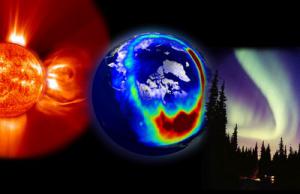Space weatherU.S. enhances national space-weather preparedness
Space-weather events are naturally occurring phenomena in the space environment that have the potential to disrupt technologies and systems in space and on Earth. These phenomena can affect satellite and airline operations, communications networks, navigation systems, the electric power grid, and other technologies and infrastructures critical to the daily functioning, economic vitality, and security of the United States. The White House Office of Science and Technology Policy said that that is why the administration the other day released a National Space Weather Strategy and National Space Weather Action Plan, and announced new commitments from the federal and non-federal sectors to enhance national preparedness for space-weather events.

Space storm generated by the sun // Source: nasa.gov
Space-weather events are naturally occurring phenomena in the space environment that have the potential to disrupt technologies and systems in space and on Earth. These phenomena can affect satellite and airline operations, communications networks, navigation systems, the electric power grid, and other technologies and infrastructures critical to the daily functioning, economic vitality, and security of the United States. The White House Office of Science and Technology Policy said that this is why the administration the other day released a National Space Weather Strategy and National Space Weather Action Plan, and announced new commitments from the federal and non-federal sectors to enhance national preparedness for space-weather events.
National Space Weather Strategy and National Space Weather ActionPlan
Over the last several years, both industry and the federal government have played an active role in maintaining and advancing the U.S. ability to forecast and mitigate the various impacts of space weather. These actions include taking steps to replace aging satellite assets essential to monitoring and forecasting space weather, proposing space-weather standards for both the national and international air space, developing regulations to ensure the continued operation of the electric grid during an extreme space weather event, proposing a new option for replacing crucial Extra High Voltage (EHV) transformers damaged by space weather, and developing domestic production sources for EHV transformers.
Yet gaps remain in the U.S. capacity to understand, model, predict, respond to, and recover from space-weather events. The newly released National Space Weather Strategy (Strategy) and Space Weather Action Plan (Action Plan) were developed by an interagency group of experts, with input from stakeholders outside of the federal government, to articulate how the federal government will work to fill these gaps by coordinating, integrating, and expanding existing policy efforts; engaging a broad range of sectors; and collaborating with international counterparts. The Strategy identifies goals and establishes the guiding principles that will guide these efforts in both the near and long term, while the Action Plan identifies specific activities, outcomes, and timelines that the federal government will pursue accordingly. The Action Plan broadly aligns with investments proposed in the president’s budget for Fiscal Year 2016 and will be reevaluated and updated within three years of the date of publication or asneeded.
